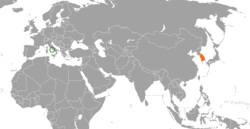Holy See–South Korea relations
 | |
Holy See |
South Korea |
|---|---|
Holy See–South Korea relationsrefers to the relations between theHoly Seeand theRepublic of Korea.The Catholic Church in South Korea is the fastest growing Church inEast Asia.According to statistics, as of December 31, 2017, the number of Catholics in Korea was 5,813,770. It amounted to 11.0% of the total population of South Korea (52 million). The total number of Catholics in Korea has slightly and consistently been increasing since the 1950s.[1]
History[edit]
Historical ties between the Vatican and South Korea can be traced back to 1946 when 1947 when BishopPatrick Byrneserved as an Apostolic Visitor to Korea from 1947 onward. The South Korean government sent a delegation to the Paris conference in 1948 to be recognized as the only government of theKorean Peninsula.At that time, the Holy See and the Apostolic Nuncio in Paris (then Angelo Roncalli, laterPope John XXIII) greatly helped the South Korean delegation to obtain recognition from many delegations of Catholic countries.[2]
In 1980, PresidentChun Doo-hwan'smilitary regime accused pro-democracy activistKim Dae-jungof inciting theGwangju uprising;a military tribunal sentenced Kim to death. In the subsequent week, PopeJohn Paul IIwrote to Chun requesting clemency for Kim (a Catholic) on humanitarian grounds. Although initially rejecting his request, Chun commuted his sentence the following month. Kim would later be elected president; the first opposition candidate to win in Korean history.[3]
In 2021, President Moon Jae-in encouragedPope Francisto visitNorth Koreaas a way to further the dialogue between the two countries and theUnited States.As of 2022, Francis has no plans to visit North Korea. It is unclear if such dialogue will continue, as the recently elected President Yoon Suk-yeol is highly critical of Moon's pro-reconciliation policies.[4]
State visits[edit]

In 1984, Pope John Paul II visited South Korea for the first time to attend a ceremony commemorating 200th anniversary of Korean Catholicism, celebrating mass in the city ofGwangju,where a pro-democracy uprising took place four years prior.[5]The pontiff made a second papal visit in 1989 to attend the 44th Eucharistic Congress.[2]He wished to also visit North Korea, but the trip never materialized.[5]Pope Francis also made a papal visit to South Korea in 2014 for the beatification of the 124Korean martyrsand for the sixth Asian Youth Day.[6]
Then Korean President Kim Dae-jung visited the Vatican in 2000, becoming the first Korean head of state to do so. He reportedly told John Paul "you saved my life, I am grateful."[3]PresidentsRoh Moo-hyun,Lee Myung-bak,Park Geun-hyeandMoon Jae-inalso made their visits to the city-state.[2]During his visit, Moon, also a Catholic, declared that peace on the Korean peninsula was "certain".[7]
Apostolic nuncios to Korea[edit]
See also[edit]
References[edit]
- ^Pettinelli, Derek (1 September 2018)."Catholicism Flourishing In South Korea".Catholic Digest.Retrieved18 February2018.
- ^abcYoon, Sojung (13 August 2014)."Historical records of Korea, Vatican ties go online".Korea.net.Retrieved24 November2014.
- ^abCNA (21 May 2009)."John Paul II's appeal saved future Korean president from death sentence".Catholic News Agency.Retrieved23 November2022.
- ^Yeung, Jessie (28 May 2022)."Exclusive: South Korea's new leader says age of appeasing North Korea is over".CNN.Retrieved23 November2022.
- ^ab"Pope John Paul's Legacy in Korea Lives on".The Chosun Ilbo.3 April 2005.Retrieved23 November2022.
- ^"Pope Francis Arrives in South Korea on First Trip to Asia as Pontiff".Wall Street Journal.Retrieved14 August2014.
- ^Winfield, Nicole (17 October 2018)."At Vatican, South Korean leader says he's certain of peace".Associated Press.Retrieved23 November2022.

